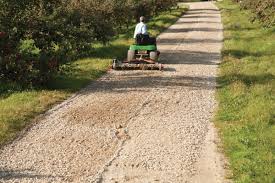How to Maintain a Gravel Driveway so that it Lasts for Decades
By Mark J. Donovan
|
|
Maintaining a gravel driveway is necessary to prevent it from slowly crumbling apart. Water runoff and frequent automobile use slowly cause potholes to form, and the edges to where down. In addition, if you live in a rocky, cold climate area, large stones hidden under the gravel driveway often work their way to the surface of the gravel driveway due to frost heaves.
Gravel driveway maintenance can be performed by a homeowner, however some rental equipment is usually involved. A small bobcat is necessary for spreading new gravel and crowning the gravel driveway, and a mechanical roller is needed for compacting the gravel. |
My summer home is located on Lake Winnipesaukee in central New Hampshire. We access the home via effectively a long gravel driveway. Once every year or so the residents who live off of this “road” / long gravel driveway put some money into it to keep it in good working order.
Typically one of the residents who utilize the long gravel driveway will obtain a few contractor bids and communicate to everyone on the “road” their per-share-cost for maintaining the gravel driveway.
Building a Gravel Driveway
If you are considering building a gravel driveway keep in mind a few key points.
First, the soil under the gravel driveway has to be well drained. All organic material such as topsoil, leaves and sticks should be removed.
Second, install a geotextile fiber fabric over the subsoil to prevent silt from the subsoil working its way upwards into the gravel driveway. The silt can cause the gravel driveway to quickly crumble.
| Third, install large stones for the base layer of the gravel driveway. The stones should be the size of a softball and should be angular in shape. Do not use smooth river rock stone as they will not lock together well.
Fourth, add another 4-6 inches of smaller stone over the base layer of stones. These stones should be approximately the size of golf balls. Again, use angular stones. Fifth, for the final layer of your gravel driveway apply 4 to 6 inches of ¾” size stone with stone dust mixed in. |
 |
After spreading the final layer of gravel, make sure to crown the road so that the center of the gravel driveway is slightly higher than the edges. This will enable water to run off the gravel driveway.
Finally, use a mechanical roller to lock the gravel into place.
By following these techniques for maintaining a gravel driveway and building a gravel driveway, you should have a driveway that last for decades.
For more help on Asphalt Driveway Paving, see HomeAdditionPlus.com’s Asphalt Driveway Paving Bid sheet. The Asphalt Driveway Paving Bid Sheet will help ensure that your hire the right contractor so that your driveway is paved correctly and you get the finished driveway you are looking for.
Related Information
- Tips on Building a Gravel Driveway
- What is the Best Time for Sealing an Asphalt Paved Driveway?
- The Advantages of an Asphalt Driveway
Additional Driveway Paving Resources
 |
 |
Driveway Paving Price Quotes For FREE, No Obligation!
Fill out our 3-5 minute quick and easy form, and receive a free price quote on painting & staining from one of our pre-screened and licensed painting & staining contractors. This process is free and there is no obligation to continue once you receive your painting price estimate. Click here.

